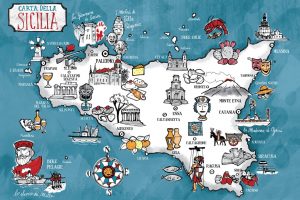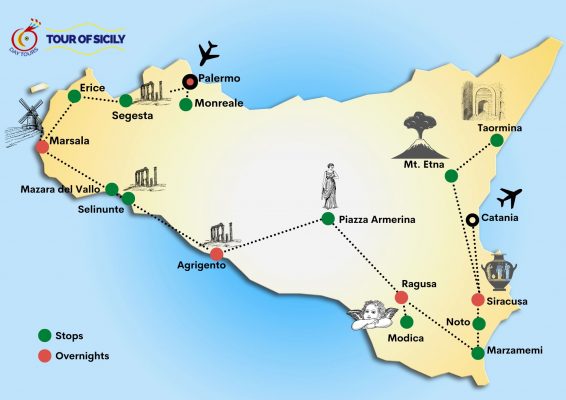11 Days in Sicily

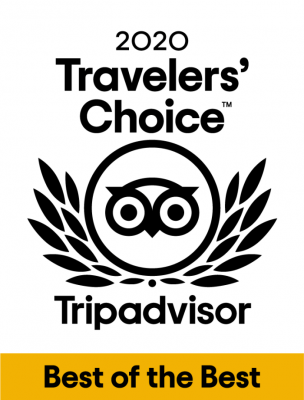
Personalized Trips to Sicily
Let me introduce you the 11 day-tour which is a good way to explore the most important local highlights of Sicily. We have shown a few different solutions which involve the west, the east, the south and the south-east.
Feel free to verify which is the one that fit your needs and expectations and in case you wish us to customize your tour feel free to share with us your needs.
Sicily at a glance
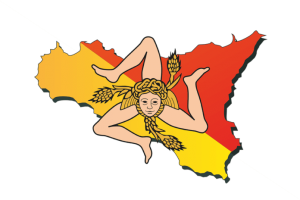 Sicily, the largest island in the Mediterranean, is a captivating blend of ancient architecture, beautiful, hidden away beaches and a bustling capital full of charisma and authentic charm.
Sicily, the largest island in the Mediterranean, is a captivating blend of ancient architecture, beautiful, hidden away beaches and a bustling capital full of charisma and authentic charm.
Thanks to its geographical location, Sicily has had the major role in the historical events that have played a key role in the Mediterranean.
The not-to-be-missed cities of Sicily
Palermo. Palermo bears witness to its past—conquered by the Phoenicians, Arabs, and Spanish, its churches and archeological remnants are unrivaled. Then the Palazzo dei Normanni and its Byzantine mosaics never fail to awe visitors; Normal Royal Palace and Palatine Chapel are divine; golden beaches of Mondello Lido, the foodie delights of the city’s markets, the Botanical Gardens—all are must-see sights in Palermo.
Monreale. The city’s Duomo is one of the greatest medieval treasures in the world—the 58,000 square feet of mosaics will take your breath away.
Siracusa and Ortygia Island. Archimedes, Cicero, Saint Paul, Caravaggio, and the naval hero Lord Admiral Horatio Nelson all made their presence known in Siracusa. In fact, Aeschylus premiered his plays at the still-functioning Teatro Greco here. One of the most beautiful squares in Italy, the Piazza del Duomo, is in the tiny island of Ortygia
Taormina. Perhaps there is no more famous name in Sicily than Taormina. This resort town draws the international jet set to its romantic alleys and glittering hotels. But Taormina is steeped in ancient history and mythology—Giardini-Naxos, Teatro Greco, and the Norman and Baroque monuments are all worth a visit.
Of course, Mt. Etna, Europe’s highest volcano, is in Taormina, and no visit to Sicily would be complete without gazing at its stunning vistas.
Mt Etna, locally called “Mongibello”, is Europe’s largest and most active volcano. Its frequent eruptions are often accompanied by large lava flows, but rarely pose danger to inhabited areas. Etna is one of the volcanoes with the longest historic records of eruptions, going back more than 2000 years. Read More
Marsala. The city is more than the sweet wines which bear its name and for which the city is famous (but don’t miss the historic Florio Winery and the Donnafugata Winery). You’ll also want to see Marsala’s salt marshes—and be sure to try busiati, the oldest handmade pasta in the world. Read More
Trapani. Ornate churches like the Cattedrale di San Lorenzo and the Torre della Colombaia define the architecture here. Don’t miss shopping for the city’s famous exquisite coral jewelry.
Ragusa. Ragusa Ibla is a fairytale of church domes and terracotta roofs. The Duomo di San Giorgio, the Giardino Ibleo, and the 18 listed UNESCO monuments will delight you.
Agrigento. The city’s greatest draw is the Valley of the Temples and its ancient Greek ruins. Tempio della Concordia is one of the best-preserved temples in the world. You’ll definitely want to visit the Museo Regionale Archeologico, perhaps the best museum in Sicily, which features the famous stone statue of Telemon (Atlas).
Catania. In a perfect world, you’d devote two full days to the art, museums, and Roman ruins of Catania. Don’t miss Duomo Square, La Pescheria (the fish market), and the Bellini Gardens.
Erice. This western Sicily gem is famous for its almond biscuits (the pastry shops here are without equal). Erice’s main church and bell tower are striking, as is the Norman castle, also known as Venus Castle, a tribute to the goddess of fertility.
Or what about Sicily’s unique cuisine—Arab and Greek spices, Spanish techniques, the world’s finest seafood. And it’s all accompanied by big, fruity, out-of-this-world wines.
Sicilian food is also considered the original fusion cuisine, a unique mix of all of its diverse cultural heritages.
The island has been at the heart of thirteen different empires over the last three millennia, and each one of them has left its mark on the Sicilian Gastronomy.
Must-try Local Dishes and Wines
Pasta alla Norma – pasta served with a special sauce made of tomatoes and fried eggplant with ricotta cheese
Arancine – fried rice balls coated with breadcrumbs and often filled with cheese or ragù sauce
Cannoli – a tube shaped pastry that is stuffed with a sweet, creamy filling often made from ricotta cheese. Read More
Caponata – a typical antipasto that you’ll encounter in every corner of Sicily; a delicious sweet and sour (agrodolce) mixture of fried eggplant, onions, celery, tomatoes, vinegar, capers, and olives, sweetened with a bit of sugar. Read More
Almond Cookies – a famous local dessert typical of Sicily. Soft and tasty, they are fast to make (and to eat…). They are also a gluten-free dessert. Read the recipe
The Chocolate in Modica – made with a very old recipe, the one coming from the Aztecs. Read More
The Predominant Grapes – Historically, Italian wine regions have clung tightly to its historical grapes, and Sicily is no different. While international varieties are prominent players, for critics, sommeliers, and importers, the wines they dream about at night are indigenous. There are three key red grapes: Nero d’Avola, Frappato and Nerello Mascalese.
Information
Travel Tips
If it is your first time to Sicily, get ready for an incredible experience!
The prospect of visiting Sicily for the first time will provoke a wide range of emotions. For some, traveling to a foreign land-especially one that doesn’t speak English – is so intimidating that any real enjoyment can only be realized with the help of a native to navigate through all the unfamiliar turf. For others, even those who don’t speak Italian, the opportunity to be immersed in an entirely new culture is part of the fun, and they look forward to feeling their way through each of the novelties that Italy throws at them.
Tipping
- Taxis: Government-regulated taxis are either white or yellow. Avoid taxis that are not metered and have no official signs. They are private cars that will charge you an expensive fee. Unlike in the U.S. where taxis are hailed on the street, in Sicily they are found at taxi stands or are called by telephone. All charges are listed on a price chart displayed inside the cab. Extra charges are in effect at night, for luggage service and phone booking. A 10% tip is expected but not mandatory.
- Restaurant tipping: Both il servizio (service charge/tip) and il coperto (cover charge for bread and water) are usually included in il conto (the bill). By Sicilian law the gratuity is included in the bill so extra tipping isn’t required. However, it is customary, especially if the service is good, to leave an additional gratuity between 5% and 10%.
- Hotel Tipping: Tipping in hotels is a customary practice. The service charge of 15% – 19% is already included in your bill. Other suggested tips include 50 euro cents per day to the chambermaid, 50 euro cents to the doorman for calling you a cab, and between 1 and 2 euros for the bellhop if he carries your bags to your room. The concierge expects about a 15% tip on his or her bill, as well as tips for any extra services. If you are staying at a 4- or 5-Star hotel these suggested amounts should be doubled.
Useful Knowledge:
- Shopping: Italian stores generally are open from 9 a.m. to 1 p.m. The siesta/pausa lunch break lasts until 4 p.m. Stores close for the day by 8 p.m. Most stores are closed on Sunday.
- Café Culture: While enjoying an espresso at a table is always possible, the locals enjoy standing at the banco, or bar area.
- Hand Gestures and Loud Voices: Unlike in the U.S. of A., hand gestures and loud voices can be a way of expressing profound happiness.
Hotel Information:
- Hotels: When looking for a place to stay, remember that rates include taxes and service; the IVA (value-added tax, currently 10%) should be added to the total amount.
- Electrical: Not all hotel rooms provide hairdryers; if you bring your own, an adapter/transformer is a necessity. This will also be important for all other electrical devices, including laptop computers, because in Italy the voltage is different (220). Also, outlets have two round-pronged plugs, which is another reason an adapter plug is necessary.
Just the Basics:
- Sicily’s Time Zone: one hour ahead of Greenwich Mean Time (GMT+1). Sicily is generally six hours ahead of Eastern Standard Time in the United States, aside from the rare instances affected by the Spring Forward/Fall Back clock-changing discrepancy when the difference is five hours.
- Country Code (for international calls to Italy): +39.
- Currency: Euro. Available in bills of 5, 10, 20, 50, 100, 200, and 500 euros; coins of 1 and 2 euros and 1, 2, 5, 10, 20, and 50 euro cents.
- Official Language: Italian and Sicilian
- Flag: The Italian tricolor is green, white, and red, in three vertical bands, equal in dimension. The Sicilian flag shows a triskeles symbol (a figure of three legs arranged in rotational symmetry), and at its centre a Gorgoneion (depiction of the head of Medusa) and a pair of wings and three wheat ears.
- Religion: Roman Catholic is the main faith – 85% of native-born citizens are nominally Catholic. There are substantial Protestant, Jewish, and Muslim communities.
- Education: Sicily has statewide education system, with a five-year primary stage and an eight-year secondary stage.
Currency
Like other member countries of the European Union, Sicily uses the euro, symbolized by “€”. For the current conversion rate between your currency and the euro you can check a currency exchange Web site such as www.xe.com
ATM Cash Machines (bancomats) are everywhere in Sicily as they are in the United States. The Cirrus and Plus systems are the most widely available. Be aware that many Sicilian cash machines will not accept card with PIN codes, five numbers or longer so be sure to reset your PIN to a four numbers before you go. You may also have a problem accessing a savings account so be sure the ATM card(s) you are bringing are linked to checking accounts. You may also be able to use your credit card for a cash advance if it has a PIN code (fees will apply).
Many travelers wonder about bringing travelers checks with them and it simply isn’t a good idea anymore. You’ll pay a fee for the checks at home, will need to find a bank (banks are usually open for a few hours in the morning and a few hours in the afternoon on week days) when it is open, wait in line and pay another service fee when receiving euros.
Credit cards are widely accepted throughout Sicily. Visa and MasterCard are more commonly accepted so if you’re bringing an American Express card, be sure to bring a Visa/MasterCard as well. Many credit card companies (Capitol One is an exception) are now charging a transaction fees for international purchases. Be sure to check with your credit card company before leaving home. Finally, cash is king in Sicily. Sicilian merchants hate paying service fees on credit card transactions and will often give you a discount (sconto) for paying cash. Of course, they also like to hide their earning from the tax authorities too, but that’s a whole other story.
Shopkeepers are also open to giving discounts if you are buying multiple items. Don’t be afraid to ask for a sconto!
City Taxes
When staying overnight in Sicily, certain cities have a tourist tax.
This Sicily City tax must be paid by the PASSENGER directly to the hotel before the end of the stay.
| City | 5 star | 4 star | 3 star | |
| Palermo | eur 3 | eur 2 | eur 1.50 | |
| Catania | eur 2.50 | eur 1.50 | eur 1.50 | |
| Taormina | eur 5 | eur 3.50 | eur 2 | |
| Syracusa | eur 2.50 | eur 2 | eur 1.50 | |
| Agrigento | eur 3 | eur 2 | eur 2 | |
| Trapani | eur 3 | eur 2.50 | eur 2 | |
| Ragusa | eur 2.50 | eur 1.50 | eur 1 | |
| Cefalù | eur 3 | eur 2 | eur 1.50 | |
| Messina | eur 4 | eur 2 | eur 1.50 |
Internet
Wireless access is prevalent in restaurants and hotels and most hotels no longer charge for you to use WiFi.
You can access it with your phone or laptop computer.
If you choose not to bring a device with you, most hotels make a desktop computer available for guests to use or have a business center available.
Sicily airports
There are four airports in Sicily, two serving the east coast (Catania and Comiso airports) and the other two (Palermo and Trapani airports) – the west coast.
Palermo Falcone & Borsellino (PMO) and Catania Fontanarossa (CTA) are the biggest airports operating actively all the year round. Both become very busy in summer months.
Trapani Birgi (TPS) and especially Comiso Pio La Torre airport mostly serve low-cost airlines and seasonal flights.
Air, sea or land?
There are ways to get to Sicily from mainland Italy or from Malta without flying.
These include long-distance buses from other regions in central (mainly Rome) and southern Italy, trains or ferries.
However, flying to one of the Sicily airports is probably the fastest, and arguably the most convenient way to arrive at your final destination.
Busy itinerary? Fly anywhere!
If you are planning to explore the island and change your location at least two or three times it does not make much difference which airport to arrive.
You can even consider to arrive at one airport and depart from the other.
This is usually convenient and optimizes timing in case you want to move around and see more. Typically Palermo and Catania would be the preferred options.
Having a clear idea of what kind of a vacation you are planning to have, and what is your itinerary will make the choice of the airports easier. It is also possible to build an itinerary around your arrival and departure points, especially if your plans are not overwhelming.
Still, east or west – what is best?
Roughly speaking, Palermo airport is an optimal arrival point to reach destinations along the west coast between San Vito lo Capo and Cefalu. Corleone and the Madonie mountains would be on the same list, just a bit away from the coastline. Trapani airport is closer than any other one to Castellammare del Golfo, the Egadi islands including Favignana, Marsala, Erice, Segesta, Mazzara del Valo and Selinunte. The southern coast from Agrigento to Trapani itself is also within easy reach.
Catania airport serves best final destinations like Taormina, the Aeolian islands, Messina, Giardini Naxos, Acireale its coast, Etna, Siracuse and Noto, Caltanissetta. Comiso is optimal for Ragusa, Scicli, Modica and Licata, while Piazza Armerina and Caltagirone are similar travel distance from both Catania and Comiso airports. Agrigento, Tindari and Enna are equally convenient from Catania and Palermo airports with Agrigento and Tindari taking some 2 -2,5h drive. These are probably the farthest among popular locations on mainland Sicily. Agrigento is similar 2 – 2.5 h drive distance from Trapani and Comiso as well.
Visiting Sicily: days, weeks, and beyond
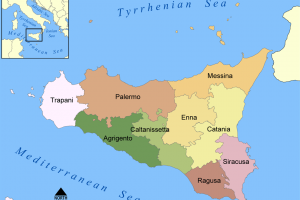 Sicily is an island and has 9 provinces (Palermo, Agrigento, Caltanissetta, Catania, Enna, Messina, Ragusa, Siracusa, Trapani), each with its own identity.
Sicily is an island and has 9 provinces (Palermo, Agrigento, Caltanissetta, Catania, Enna, Messina, Ragusa, Siracusa, Trapani), each with its own identity.
Landscapes, cuisine, and dialect differ greatly from one to the next, and each merits its own visit.
If your time is limited, you’ll be able to see Sicily’s highlights in a matter of days—but spending one week or more means you’ll get to explore multiple provinces and fall in love with the authentic Sicily.
If you have a few days in Sicily, it’s best to focus on one city, otherwise you’ll likely feel like you’re spreading yourself too thin!
In three or four days lodge in one city only and from here explore and enjoy the area.
The most important cities are Palermo — located on the west side — Taormina and Syracusa — both located on the east –.
In one week, you’ll be able to explore Sicily’s wonderful cultural cities, undoubtedly a highlight of any trip to the country. Palermo, Agrigento, Taormina and Syracusa attract the bulk of tourists and justifiably so—they harbor some of the world’s most impressive architecture and works of art.
Nine days will give you more time to explore what Sicily offers beyond the usual tourist destinations. You’ll be able to travel along the stunning Marsala, Erice, Ragusa, Modica and Noto, which offer some of Europe’s most enchanting scenery.
However, to experience Sicily at its best, you’ll need to factor in two weeks. That way, you’ll have enough time to discover a large part of the island and one (or perhaps both!) of its major islands, Lipari and Vulcano.
Interesting facts
 Treat yourself with the amazing Original Cannoli, a Sicilian speciality made of crispy dough and a creamy ricotta cheese filling.
Treat yourself with the amazing Original Cannoli, a Sicilian speciality made of crispy dough and a creamy ricotta cheese filling.
A dessert now known and appreciated all over the world, a pillar of “Sicilian Culture“. We can safely say that visiting Sicily without eating cannoli is like not having visited it at all.
For those who do not know it (We doubt there is someone who does not know what we are talking about) the Sicilian cannoli is a dessert consisting of a crunchy fried wafer in lard, called “scorza (rind)“, filled with sheep’s ricotta cream with a sprinkling of chocolate or pistachio and candied fruit at both ends.
Explore Sicily in 11 days
On this eleven-day itinerary, you’ll uncover layers of history in the island of Sicily. Is a sort of showcase where you can immerse your senses in the art, culture and gastronomy!
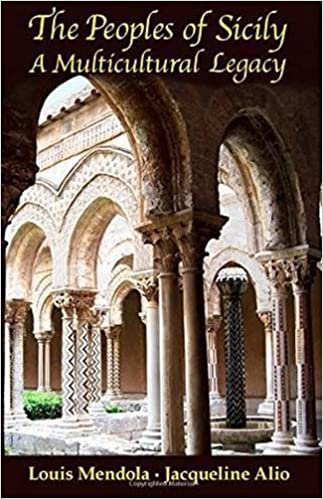 Sicily is the largest island in the Mediterranean, just off the ‘toe’ of Italy’s boot. It’s also an island with a unique, eclectic, and rich history: Sicily was first ruled by the Phoenicians, followed by the Greeks, followed by the Romans. After the Romans came the Muslims, followed by the Normans, Muslims, Spanish, and finally, Italians. Each of them made an indelible imprint on Sicilian Culture, Gastronomy, Wine and Olive Oil. Sicily represents the set of all the Mediterranean culinary traditions concentrated in a single small and amazing island!
Sicily is the largest island in the Mediterranean, just off the ‘toe’ of Italy’s boot. It’s also an island with a unique, eclectic, and rich history: Sicily was first ruled by the Phoenicians, followed by the Greeks, followed by the Romans. After the Romans came the Muslims, followed by the Normans, Muslims, Spanish, and finally, Italians. Each of them made an indelible imprint on Sicilian Culture, Gastronomy, Wine and Olive Oil. Sicily represents the set of all the Mediterranean culinary traditions concentrated in a single small and amazing island!
Some travelers pass through for a day or two on their way to other destinations, but eleven days is an ideal amount of time to get a feel of Sicily lifestyle.
The Peoples of Sicily Book, at 368 pages, the most revealing history of ancient and medieval Sicily to find its way into print took seven centuries to write. Read this one if you love history, but especially if you don’t. Because here history is just the beginning … and because this story is about much more than an island in the Mediterranean Sea. Learn More
Highlights
1st day – Arrival in Palermo airport – Transfer to Palermo
2nd day – Palermo and Monreale
3th day – Palermo to Marsala (visiting: Segesta, Olive Oil and Erice)
4th day – Marsala Experience (visiting: Saltpans, Motya Charioteer and Winery)
5th day – Marsala to Agrigento (visiting: Mazara Kasbah Maze, Couscous and Selinunte)
6th day – Agrigento to Ragusa (visiting: Valley of the Temples and Mosaics at the Roman villa)
7th day – Ragusa and Modica Aztec’s Chocolate Tasting
8th day – Ragusa to Siracusa (visiting: Noto and Tuna Fishing Village)
9th day – Siracusa and Ortigia Half Day
10th day – Etna Volcano, Winery and Taormina
11th day – Departure from Catania airport – Transfer from Siracusa
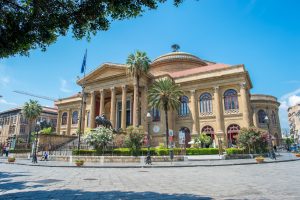 The eleven day tour begins on the second day at the Palermo Opera House and continue to the the Four Corners which is the junction in Palermo. Going south-east down Via Maqueda you will come across Piazza Pretoria which is home not only to a splendid fountain but several other impressive buildings including, on the right, the City Hall. The fountain, known for generations as the “Fountain of Shame”, has an interesting history. Later to the Palatine Chapel, a UNESCO World Heritage Site, located inside the complex of Royal Palace. This afternoon a short drive takes us to Monreale to see where Arab-Norman art and architecture reached its pinnacle in the Duomo, launched in 1174 by William II. Learn More
The eleven day tour begins on the second day at the Palermo Opera House and continue to the the Four Corners which is the junction in Palermo. Going south-east down Via Maqueda you will come across Piazza Pretoria which is home not only to a splendid fountain but several other impressive buildings including, on the right, the City Hall. The fountain, known for generations as the “Fountain of Shame”, has an interesting history. Later to the Palatine Chapel, a UNESCO World Heritage Site, located inside the complex of Royal Palace. This afternoon a short drive takes us to Monreale to see where Arab-Norman art and architecture reached its pinnacle in the Duomo, launched in 1174 by William II. Learn More
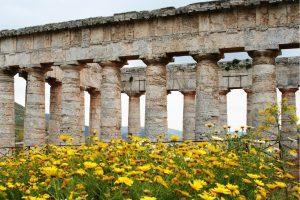 On the thrid day embark on a morning drive through western Sicily and view the famous Doric Temple of Segesta rising high on a hill, which was constructed in the 5th century B.C. and is one of the greatest examples of this Doric style of architecture. Afterward, savor lunch with an olive oil tasting at a local farm. Continue to the mountaintop Erice, a wonderfully preserved medieval town with breathtaking views and a great historical presence. Wander through its ancient streets and visit some of the famous homemade pastry shops — world-famous for marzipan candies and other delicacies like almond and pistachio pastries – and the lovely preserved Mediaeval town offering the most breathtaking views and a palpable sense of history. We then travel from Erice to Trapani-Marsala Salt Way Road, skirting the lagoon to see the snow-capped mountains but hills of salt, one of the Sicilian economy’s historical resources that was already very precious in the days of the Phoenicians, who were the first to bring some form of technology to its production. We then arrive in Marsala, the Harbour of God. Learn More
On the thrid day embark on a morning drive through western Sicily and view the famous Doric Temple of Segesta rising high on a hill, which was constructed in the 5th century B.C. and is one of the greatest examples of this Doric style of architecture. Afterward, savor lunch with an olive oil tasting at a local farm. Continue to the mountaintop Erice, a wonderfully preserved medieval town with breathtaking views and a great historical presence. Wander through its ancient streets and visit some of the famous homemade pastry shops — world-famous for marzipan candies and other delicacies like almond and pistachio pastries – and the lovely preserved Mediaeval town offering the most breathtaking views and a palpable sense of history. We then travel from Erice to Trapani-Marsala Salt Way Road, skirting the lagoon to see the snow-capped mountains but hills of salt, one of the Sicilian economy’s historical resources that was already very precious in the days of the Phoenicians, who were the first to bring some form of technology to its production. We then arrive in Marsala, the Harbour of God. Learn More
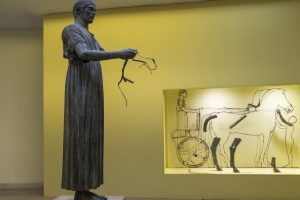 On the fourth day a short drive to the Saltpans Ettore Infersa which offer a truly unique landscape. Then boarding your boat to cruise on the Stagnone Lagoon to the island of Motya, an ancient trading outpost for Phoenician merchants. Here, you will see the beautiful and unique marble statue of the Motya Charioteer, a Greek influenced masterpiece dated back to the 5th century BC. Time for lunch on your own, before continuing to visit a local Winery located in Marsala to taste the Marsala Wine with snack. The Marsala is the oldest Italian DOC wine, with an average alcohol content of about 18 degrees. Learn More
On the fourth day a short drive to the Saltpans Ettore Infersa which offer a truly unique landscape. Then boarding your boat to cruise on the Stagnone Lagoon to the island of Motya, an ancient trading outpost for Phoenician merchants. Here, you will see the beautiful and unique marble statue of the Motya Charioteer, a Greek influenced masterpiece dated back to the 5th century BC. Time for lunch on your own, before continuing to visit a local Winery located in Marsala to taste the Marsala Wine with snack. The Marsala is the oldest Italian DOC wine, with an average alcohol content of about 18 degrees. Learn More
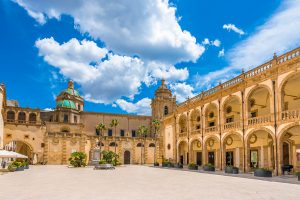 On the fifth day departure for Mazara. At the northwest corner of the historic centre, this multicultural maze of narrow streets was once the heart of the Saracen city. The main thoroughfare was Via Bagno, which still has its hammam (public baths). Today the area is rundown but interesting, in large part because it retains a strong Arab connection through the Tunisian immigrants who now live here. Enjoy a Couscous lunch topped with seafood and served with an intensely rich fish stock seasoned with cinnamon, bay leaves, and almonds, it’s one of Sicily’s most famous—and delicious—dishes. In the afternoon a short drive takes us to Selinunte, one of Sicily’s great Greek archaeological sites, designated a UNESCO World Heritage Site. Situated by the sea in the south-western corner of Sicily, the isolated ruins here have stood abandoned for most of their history. Learn More
On the fifth day departure for Mazara. At the northwest corner of the historic centre, this multicultural maze of narrow streets was once the heart of the Saracen city. The main thoroughfare was Via Bagno, which still has its hammam (public baths). Today the area is rundown but interesting, in large part because it retains a strong Arab connection through the Tunisian immigrants who now live here. Enjoy a Couscous lunch topped with seafood and served with an intensely rich fish stock seasoned with cinnamon, bay leaves, and almonds, it’s one of Sicily’s most famous—and delicious—dishes. In the afternoon a short drive takes us to Selinunte, one of Sicily’s great Greek archaeological sites, designated a UNESCO World Heritage Site. Situated by the sea in the south-western corner of Sicily, the isolated ruins here have stood abandoned for most of their history. Learn More
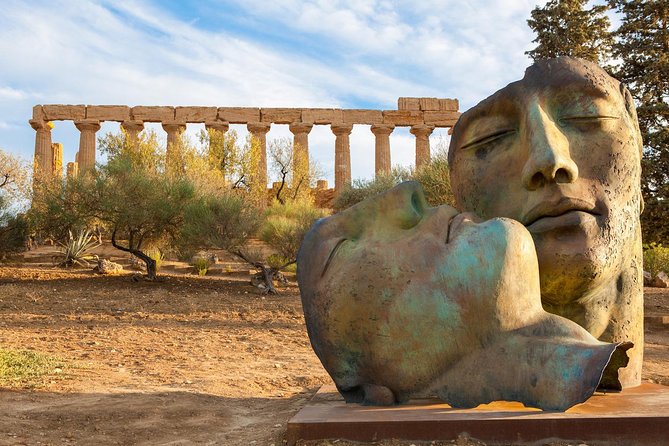 And today, the sixth, we discover Agrigento’s celebrated Valley of the Temples, the largest and best preserved temple ruins outside of mainland Greece. This afternoon, travel to Piazza Armerina to view the intricate examples of Roman mosaics at the famous Roman Villa del Casale, designated a UNESCO World Heritage Site. Learn More
And today, the sixth, we discover Agrigento’s celebrated Valley of the Temples, the largest and best preserved temple ruins outside of mainland Greece. This afternoon, travel to Piazza Armerina to view the intricate examples of Roman mosaics at the famous Roman Villa del Casale, designated a UNESCO World Heritage Site. Learn More
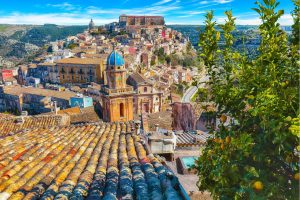 On the seventh day we indulge in the Baroque atmosphere of Ragusa-Ibla, with its breathtaking sights of houses, churches, and palaces that seem layered on top of one another. Today our lunch indulge you to taste the local Ravioli stuffed with ricotta cheese and fresh tomato sauce. After lunch, travel to Modica, known all over the world for its chocolate production. Modica is custodian of a 400 year tradition of Sicilian chocolate-making. Being part of the Spanish kingdom for so many years meant that Sicily was often one of the first recipients of the new foodstuffs being brought back from South America. Cacao was one of these and today Modica still specialises in making granulous chocolate, often flavoured with chilli pepper, cinnamon or vanilla, that is based on Aztec methods and recipes. Learn More
On the seventh day we indulge in the Baroque atmosphere of Ragusa-Ibla, with its breathtaking sights of houses, churches, and palaces that seem layered on top of one another. Today our lunch indulge you to taste the local Ravioli stuffed with ricotta cheese and fresh tomato sauce. After lunch, travel to Modica, known all over the world for its chocolate production. Modica is custodian of a 400 year tradition of Sicilian chocolate-making. Being part of the Spanish kingdom for so many years meant that Sicily was often one of the first recipients of the new foodstuffs being brought back from South America. Cacao was one of these and today Modica still specialises in making granulous chocolate, often flavoured with chilli pepper, cinnamon or vanilla, that is based on Aztec methods and recipes. Learn More
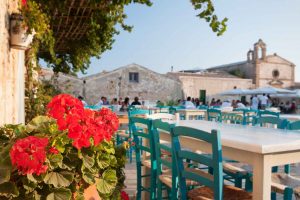 Today, the eighth day, we travel to Noto, a wonderful Baroque town, where you will have time to wander and discover one of the most spectacular urban settlements. Situated in the south-eastern corner of Sicily, Noto is famous for its Baroque architecture, and since 2002 it has been part of the UNESCO World Heritage Site ‘Late Baroque Towns of the Val di Noto’. A few kilometers away, directly overlooking the sea, It is Marzamemi, with its tunny fishing nets dated 1600, one of the most important in Sicily, with its docks for yachting boats, ruins of ancient vessels, narrow alleys, beaches impressed at sight, traditional cuisine which highlights the strong and original fishing tastes, and the wise processing of fishing products (red tuna bottarga), very often matched to the tomato of the nearby Pachino. Learn More
Today, the eighth day, we travel to Noto, a wonderful Baroque town, where you will have time to wander and discover one of the most spectacular urban settlements. Situated in the south-eastern corner of Sicily, Noto is famous for its Baroque architecture, and since 2002 it has been part of the UNESCO World Heritage Site ‘Late Baroque Towns of the Val di Noto’. A few kilometers away, directly overlooking the sea, It is Marzamemi, with its tunny fishing nets dated 1600, one of the most important in Sicily, with its docks for yachting boats, ruins of ancient vessels, narrow alleys, beaches impressed at sight, traditional cuisine which highlights the strong and original fishing tastes, and the wise processing of fishing products (red tuna bottarga), very often matched to the tomato of the nearby Pachino. Learn More
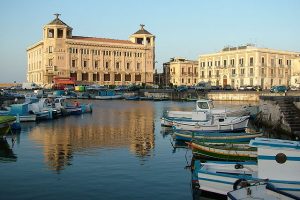 The nineth days is dedicated to Syracusa. Our first stop today is the visit to the Archaeological area of the Neapolis and get a glimpse of Siracusa as it was in ancient times with its Greek theater, the remains of Roman Amphitheater, and the “Ear of Dionysius,” an awe-inspiring artificial limestone cave renowned for its outstanding acoustics. Then onto the “Old City-Città Vecchia”, a UNESCO World Heritage Site, located on the island of Ortigia. The balance of the day is at leisure. Learn More
The nineth days is dedicated to Syracusa. Our first stop today is the visit to the Archaeological area of the Neapolis and get a glimpse of Siracusa as it was in ancient times with its Greek theater, the remains of Roman Amphitheater, and the “Ear of Dionysius,” an awe-inspiring artificial limestone cave renowned for its outstanding acoustics. Then onto the “Old City-Città Vecchia”, a UNESCO World Heritage Site, located on the island of Ortigia. The balance of the day is at leisure. Learn More
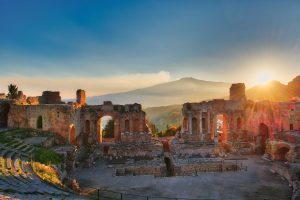 The tenth day begins with a visit to the lava-crusted slopes of Mt. Etna, which dominates the scenery and is the most active volcano in Europe! Ascend via cable car and jeep to reach the altitude of 9,000 feet; step carefully on the varied layers of lava which have solidified over the centuries. Learn about Etna’s impact on the surrounding area and its unique geology. Stop to sample some typical street food for lunch before heading toward Taormina, where you will take a walk on the main Corso Umberto, followed by free time to enjoy the city. Visit the massive Greek Roman Theater, from where you can admire the remarkable panoramas of the city and countryside. Learn More
The tenth day begins with a visit to the lava-crusted slopes of Mt. Etna, which dominates the scenery and is the most active volcano in Europe! Ascend via cable car and jeep to reach the altitude of 9,000 feet; step carefully on the varied layers of lava which have solidified over the centuries. Learn about Etna’s impact on the surrounding area and its unique geology. Stop to sample some typical street food for lunch before heading toward Taormina, where you will take a walk on the main Corso Umberto, followed by free time to enjoy the city. Visit the massive Greek Roman Theater, from where you can admire the remarkable panoramas of the city and countryside. Learn More
TOP 4 Private Tours
Gold Tour – Private Tour of Sicily
Agrigento, Erice, Etna, Marsala, Modica, Monreale, Palermo, Ragusa, Siracusa, Taormina, Turkish Steps - RealmonteGold Tour - Private Tour of Sicily: an amazing way to visit the island of Sicily in 8 days.8 Days7 Nights- Multidays
- Private Tour
- All Year
Start fromOn the roots of White Lotus season 2 – Private Tour of Sicily
We have announced a new Tour of Sicily: on the roots of the White Lotus tour that takes you to many of the real-life settings from the award-winning comedy's Season 2, set in Sicily: an amazing way to visit the island of Sicily in 8 days.8 Days7 Nights- Multidays
- Private Tour up to 6 people
- All Year
Start fromSicilian Experience – Private Tour of Sicily
Agrigento, Cefalù, Erice, Etna, Marsala, Modica, Monreale, Palermo, Piazza Armerina, Ragusa, Siracusa, TaorminaSicilian Exerience: Private Tour of Sicily: an amazing way to visit the island of Sicily in 10 days.10 Days9 Nights- Multidays
- Private Tour
- All Year
Start fromSicilian Highlights – Private Tour of Sicily
Agrigento, Etna, Palermo, Piazza Armerina, TaorminaSicilian Highlights - Private Tour of Sicily: an amazing way to visit the island of Sicily in 7 days.7 Days6 Nights- Multi Days
- Private Tour
- All Year
Start from

